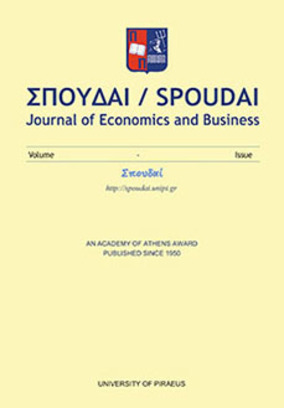Women’s time use with ICT and physical travel in Greek urban and rural areas
Part of : Σπουδαί : journal of economics and business ; Vol.62, No.1-2, 2012, pages 72-91
Issue:
Pages:
72-91
Abstract:
Information and Communications Technologies (ICT) can contribute to the modification and development of new patterns of behaviour by individuals in their everyday lives. The implementation of e-activities such as teleworking, tele-education or tele-shopping cut down the need for physical mobility thus enabling individuals to manage and tailor their time to their optimum advantage. On the other hand, e-activities can be complementary to physical activities or can even bring up derived demand for travel for new activities. This paper seeks to obtain more insight into how women in Greece allocate their time during, a typical weekday/week to various types of activities while, it explores the role of ICT during the activities being conducted. A computerized telephone (CATI) survey took place in 2009 and involved the collection of 500 questionnaires. The analysis of the data collected shows that women living in less favourable regions, prefer to use traditional means of transport for their usual activities, mainly due to their limited familiarity with the use of computers and to the smoother traffic conditions. Moreover, women with children tend to use e-means for longer periods, when executing specific activities during a typical weekday/week. The future scenarios show that under certain conditions (i.e. ICT accessibility, traffic conditions, governmental incentives) the activity may bring more utility if carried out via ICT than by physical travel. For some women, “virtual mobility” offers attractive advantages in the context of much of their administrative personal business (administrative chores, financial transactions, comparison shopping, etc.), some of their retail trips and perhaps their daily commute.
Subject (LC):
Keywords:
women, ICT, activities, time use
Notes:
Περιέχει διαγράμματα, πίνακες και βιβλιογραφία
References (1):
- Andreev, P., Salomon, I. and Pliskin, N., 2010. Review: State of Teleactivities. Transportation ResearchPart C, Volume 18, pp. 3-20.Bayarma, A., Dijst, M. and Ettema, D., 2010. Working from 9 to 6? An analysis of in-Home andOut-of-Home Working Schedules. Transportation, Volume 37, Number 3, pp. 505-523.Bonsall, P.W. and Shires, J.D., 2006. Employers’ Expectations for Commuting & Business-RelatedTravel in an ICT-Rich Environment. Transportation Research Record 1977, pp. 268-276.Bhat, C.R., Sivakumar, A. and Axhausen, K.W., 2003. An Analysis of the Impact of Informationand Communication Technologies on Non-Maintenance Shopping Activities. TransportationResearch Part B, 37, pp. 857-881.Casas, J., Zmud, J. and Bricka, S., 2001. Impact of Shopping via Internet on Travel for ShoppingPurposes. Paper Presented at 80th Annual Meeting of the Transportation Research Board,Washington, DC.Choo, S., Mokhtarian, P.L. and Salomon, I., 2005. Does Telecommuting Reduce Vehicle-MilesTraveled? An Aggregate Time Series Analysis for the US. Transportation 32, pp. 37-64.Douma, F., Wells, K., Horan, T.A. and Krizek, K.J., 2000. ICT and Travel in the Twin Cities MetropolitanArea: Enacted Patterns Between Internet Use and Working and Shopping Trips.Paper presented at The Transportation Board 83rd Annual Meeting.Washington, D.C. January11-15 paper number 04-3783.Farag, S., Schwanen, T., Dijst M. and Faber, J., 2007. Shopping Online and/or in-Store? A StructuralEquation Model of the Relationships Between e-Shopping and in-Store Shopping. TransportationResearch Part A: Policy and Practice. Volume 41, Issue 2, February 2007, pp. 125-141.Ferrell, C.E., 2005. Home-based Teleshopping and Shopping Travel: Where do we Find the Rime?Transportation Research Record, 1926, pp. 212-223.Gould, J. and Golob, T.F., 1997. Shopping Without Travel or Travel Without Shopping? An Investigationof Electronic Home Shopping. Transport Reviews 17, pp. 355-376.Gould, J., Golob, T.F. and Barwise, P., 1998. Why Do People Drive to Shop? Future Travel andTelecommunications Tradeoffs. UCI-ITS-AS-WP-98-1, Institute of Transportation Studies,University of California, Irvine.Ha, S. and Stoel, L., 2009. Consumer e-Shopping Acceptance: Antecedents in a Technology AcceptanceModel. Journal of Business Research, Volume 62, Issue 5, May 2009, pp. 565-571.Hjorthol, R., 2008. The Mobile Phone as a Tool in Family Life: Impact on Planning of EverydayActivities and Car Use. Transport Reviews, Vol. 28, No 3, pp. 303-320.Mayoux, L., 2001. Jobs, Gender and Small Enterprises: Getting The Policy Environment Right,ILO Working Papers 346709, International Labour Organization.Kitrinou, E., Polydoropoulou, A. and Bolduc, D., 2010. Development if Integrated Choice and LatentVariable Models for the Residential Relocations Decision in Island Areas. Choice Modelling:The State of the Art and the State of Practice. Chapter 27, pp. 593-618. ISBN:978-1-84950-772-1.Kitrinou, E. and Polydoropoulou, A., 2009. Modeling the Impact of ICT-Use and Teleworking onResidential Relocation Decision in Island Areas. Statistical Review, Journal of the Greek StatisticalAssociation.Ming-Hsiung, H., 2009. Shopping Mode Choice: Physical Store Shopping versus e-Shopping. TransportationResearch Part E: Logistics and Transportation Review, Volume 45, Issue 1, January2009, pp. 86-95.Mokhtarian, P.L., 2002. Telecommunications and Travel: The Case for Complementarity. Journalof Industrial Ecology 6, 2: 43-57.Mokhtarian, P.L., 2009. If Telecommunication is Such a Good Substitute for Travel, Why DoesCongestion Continue to Get Worse? Transportation Letters: the International Journal ofTransportation Research, Issue 1, pp. 1-17.Nagurney, A., June Dong and Mokhtarian, P.L., 2001. Teleshopping Versus Shopping: a MulticriteriaNetwork Equilibrium Framework. Mathematical and Computer Modelling, Volume34, Issues 7-8, October 2001, pp. 783-798.Padayhag, G.U., 2009. The Effect of ICT Use on Time Planning of Social Activities: The Experiencein Metro Manila, Philippines. Proceedings of the International Association of Transportationbehavioral Research IATBR, Jaipur, India.Papola, A. and Polydoropoulou, A., 2006. Shopping-Related Travel in a Rich ICT Era: A CaseStudy on the Impact of e-Shopping on Travel Demand. Paper Presented at the 85th TRBMeeting, January 22nd-26th, Washington DC, 2006.Rotem-Mindali, O., 2010. E-tail versus Retail: The Effects on Shopping Related Travel EmpiricalEvidence from Israel. Transport Policy, Volume 17, Issue 5, September 2010, pp. 312-322.Rotem-Mindali, O. and Salomon, I., 2007. The Impacts of E-retail on the Choice of ShoppingTrips and Delivery: Some Preliminary Findings. Transportation Research Part A: Policy andPractice, Volume 41, Issue 2, February 2007, pp. 176-189.Viswanathan, K. and Goulias, K.G., 2001. Travel behavior implications of information and communicationstechnology ICT in Puget Sound region. Transportation Research Record, 1752,pp. 157-165.Wang, D. and Law, F., 2007. Impacts of Information and Communication Technologies ICT onTime Use and Travel Behaviour: A Structural Equation Analysis, Transportation, Vol. 34,No 4, pp. 513-527.




